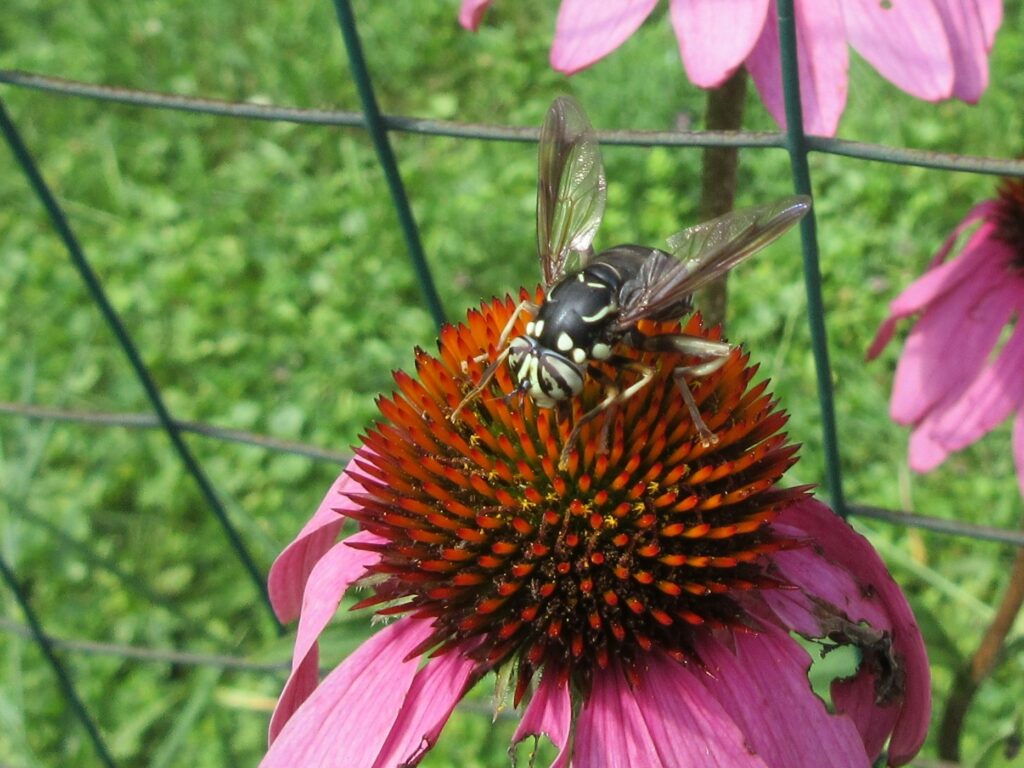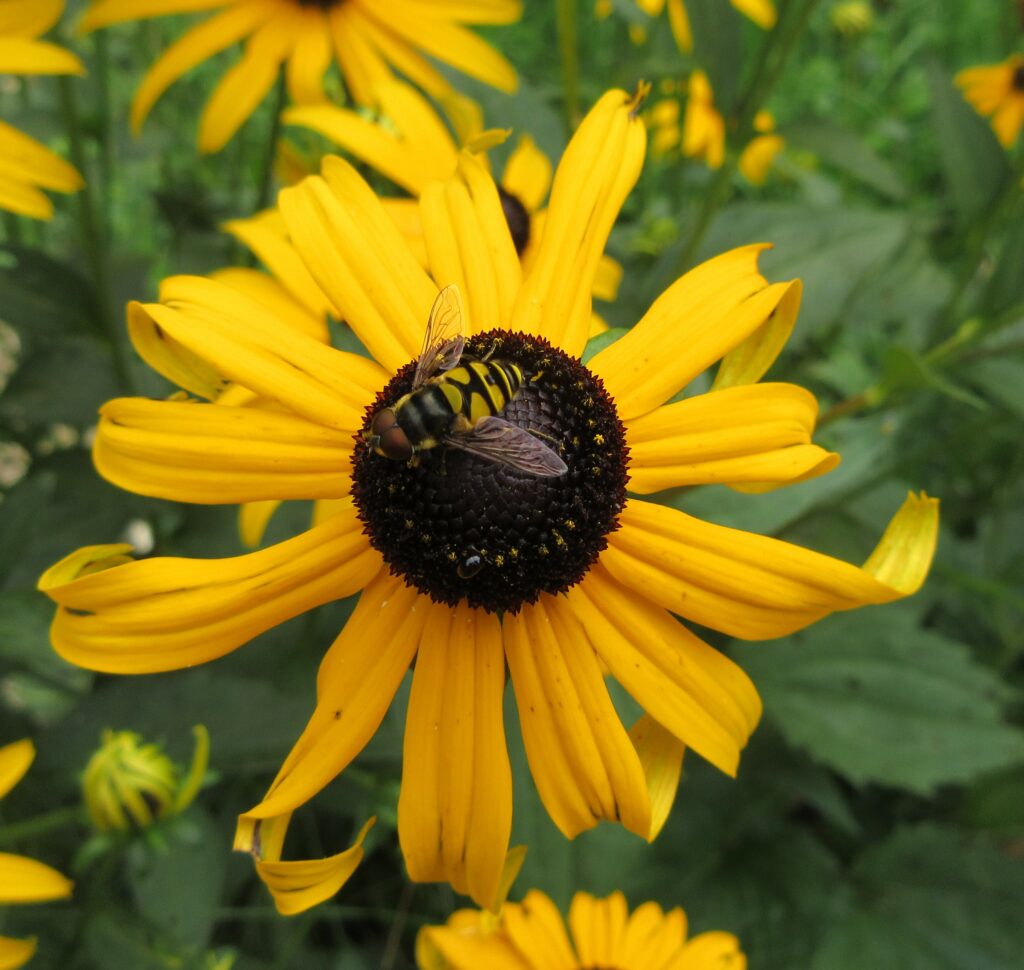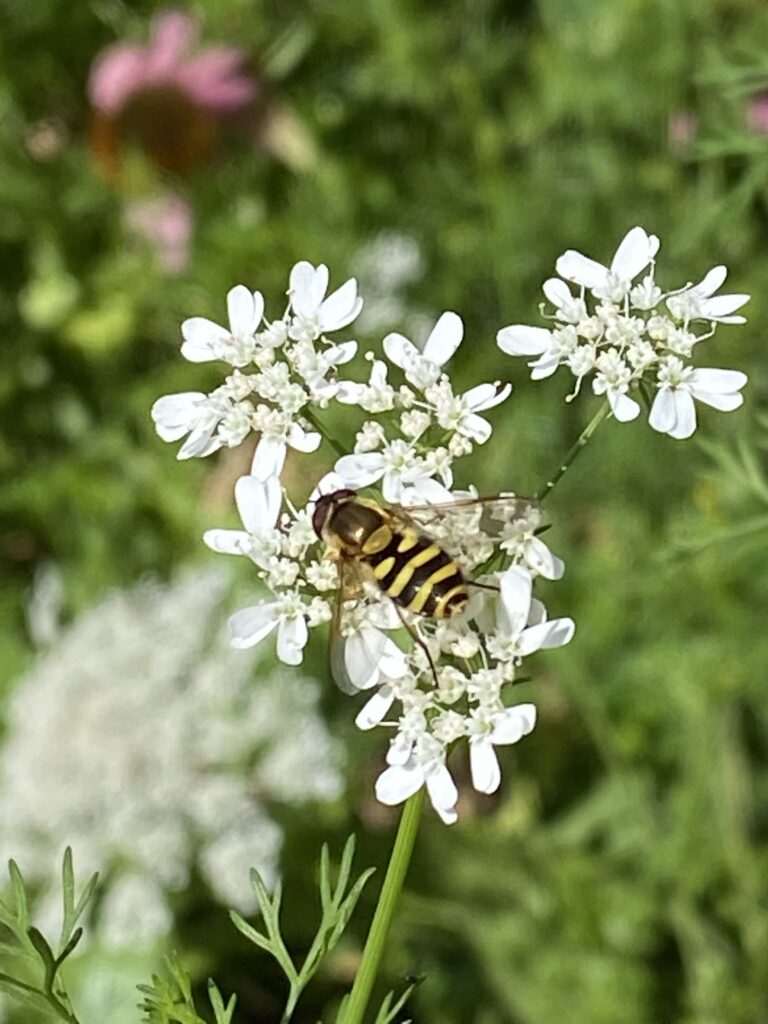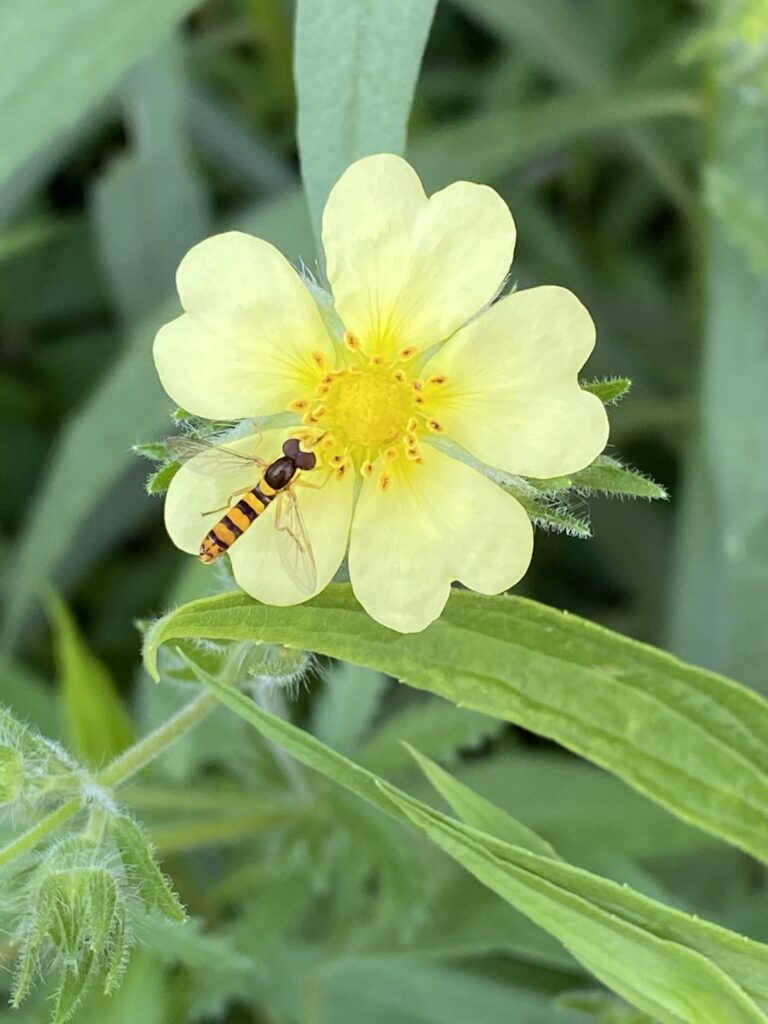by Sue Smith-Heavenrich

This may look like a scary bald-faced hornet, but it’s really a syrphid fly (Spilomyia fusca). Photo by Sue Smith-Heavenrich
If you garden, you’ve seen flower flies, though you may not recognize them. They’re the ones that look like bees and wasps and hang out on many of the same flowers that bees visit. Flower flies are also called hoverflies because of their ability to hang in midair by rapidly vibrating their wings. They belong to the fly family Syrphidae and are recognized by their yellow-and-black stripes, though they can also have red, orange or brown markings. Syrphid flies come in a range of sizes, from a quarter inch to just over an inch in length. And though some hum like bees, none of them have stingers.
My appreciation of syrphid flies began one sunny day in late July. While counting pollinators in my garden I came nose-to-eye with the biggest bald-faced hornet I’d ever seen. It was easily an inch long, perched on the disk of a purple coneflower. For a moment I froze, because I have great respect for stinger-wielding Hymenoptera. In the next moment I realized that, like the insect-devouring birds flitting from fence post to apple tree, I had been fooled!
The bug in question bore the bold black-and-white markings of a hornet and buzzed in a convincing manner. But its eyes were too big, its face less pointed, its antennae shorter by half. And then there was the way it held its wings — only two of them — and its nonchalant behavior toward me.
This was a fly in disguise! Just like the bee mimics I was familiar with, this sturdy Spilomyia fusca belonged to the Syrphid family. Once my heartrate returned to normal, I added it to the day’s pollinator list.
Flower Flies of Maine
There are nearly 900 species of Syrphidae in North America. They feed on nectar and pollen and transport pollen from one flower to another. The Northeast is home to more than 400 syrphid species, enough to warrant its own field guide, and a good number spend their lives in the vacation state. A species checklist from a 1946 survey of the Mount Desert Region in Maine lists more than 140 different syrphid flies. More recently, fly-watchers from Kittery to Caswell and Lubec to Stow have entered more than 1,900 observations in the iNaturalist app. They include such species as the wavy mucksuckers and long-nosed swamp flies, calligraphers and leafwalkers, meadow flies, pond flies, thintails, streaktails and globetails.
Unsung Pollinators
Syrphid flies haven’t been studied as much as honeybees, bumblebees, or even our native bees. But when it comes to pollinating, they are every bit as hardworking as bees. Researchers estimate that syrphids and other flies contribute to the pollination of at least 70% of food crops. They peg the economic value of fly pollination at around $300 billion worldwide. Flies are key pollinators of a number of commercial crops, including mango, cashew and avocado. Syrphids may even be more effective than honeybees in some crops such as oilseed rape. When researchers introduced a population containing four species of syrphids into a strawberry crop, they noticed an increased fruit yield. Their data also showed that the number of marketable berries was doubled.

Some farmers include blossoms in their flower strips to attract the syrphids that pollinate their peaches, pears, plums and apricots. Syrphid flies also pollinate raspberries and blackberries, and some farmers use flower flies to pollinate their greenhouse peppers.
Adult syrphid flies need pollen in order to produce their eggs. But they don’t have as many bristles and hairs as bumblebees, nor do they have specialized structures for carrying pollen. So on a per-trip basis, a flower fly won’t carry as much pollen as a bee does. But syrphids make up for that by spending more time in the fields and gardens. Unlike bees, which have to carry pollen back to their hives, flies don’t build nests. Instead, they sleep on the undersides of leaves and in tall grasses. Time saved by not commuting to a nest translates into more flower visits.
Amazing as syrphids are, they aren’t the only flies visiting your flowers. House flies and others in the family Muscidae are important pollinators in arctic and alpine regions. These small, gray flies also pollinate crabapples and sweet-smelling garden flowers. Bee flies (family Bombyliidae) look like round, fuzzy bumblebees, even flying about with their long tongues hanging out. Look for them around primroses, self-heal and forget-me-nots. And don’t be surprised if you see shiny, metallic blue and green bottle flies taking a leisurely lunch break on your black-eyed Susans, dill and yarrow.
Aphid Slayers
Adult syrphid flies are gentle flower feeders, but their larvae can be vicious aphid slayers. Since syrphid moms don’t provision nests for their young, they lay their eggs right next to their food source: a leaf or stem covered with aphids or other soft-bodied insects. Syrphid eggs are easy to miss. They look like tiny grains of rice. But give them three days and that’s when the yellowish, slug-like larva hatch. Those larvae are hungry. They are also legless and blind, so it’s a good thing food is right there on the leaf.
Farmers who appreciate syrphid larvae call them “aphid slayers.” That’s because a single larva can eat 20 to 30 aphids a day, consuming nearly 400 aphids in the two weeks prior to pupating. That’s comparable to the number of aphids a ladybeetle larva consumes in its first couple weeks. But aphids aren’t the only thing on the menu. Some syrphid fly larvae chow down on thrips and mealy bugs, munch leafhoppers and dine on tiny cabbageworms.
Researchers found that planting one or two sweet alyssum plants for every 50 lettuces attracted enough syrphids to control aphids and other pests. Other researchers showed that other crops, including collards and apple trees, benefitted from syrphid populations. Apple trees growing near sweet alyssum flowers benefitted from lowered populations of woolly apple aphids.
After around 10 days as a pupa, adult syrphids emerge to continue the cycle. Over the span of a growing season, syrphid flies produce anywhere from three to seven generations of pest-devouring larvae. Of course, they aren’t the only insects out there killing off the pests, but they can help reduce aphid populations on crops.
Is It a Fly or a Wasp?
To determine whether that buzzing stripey insect is a fly or a wasp, you need to get a closer look. But not too close: 6 to 10 inches will allow a good view without getting into the personal space of aggressive insects.
The first thing you might notice is the head. Bees and wasps have long antennae that are made up of segments. A syrphid fly’s antennae tend to be short and stubby. Sometimes they look like tiny clubs angled downward. Check out their eyes, too. Fly eyes are so big that they often meet at the top of their head. Bee and wasp eyes are not as large, sit on the sides of the head, and don’t meet at the top.

Wings are probably the easiest way to distinguish flies from other insects. Bees and wasps have two pair of wings — for a total of four. When resting, bees fold their wings across their backs. Flies have only one pair of wings — that’s two, total — and tend to hold their wings out to the side while sitting on a flower.
While you’re observing them, check out the thorax and abdomen. Bees have bristles and hair all over their bodies. Syrphid flies have smoother bodies with few hairs.
Planting Flowers for the Flies
If you want syrphid fly larvae munching your garden pests, you’ll need to attract their moms with the kinds of flowers they love. Because syrphids are generalists, they’ll happily slurp down nectar and pollen from a variety of flowers. Because they have short, unspecialized mouthparts, they prefer flat, open flowers or clusters of small flowers where they can perch on the petals. And because they’re around throughout the growing season, syrphids need a variety of blossoms that bloom over a long range of time.

So this spring, as you consider your pollinator plants, sow some seeds for the syrphids. Plant extra herbs and let a few go to flower. Better yet, let some “weeds” bloom in your pollinator patch. Here are some flower fly favorites:
- asters
- basil flowers
- black-eyed Susan
- buckwheat
- calendula
- chamomile
- chicory
- chives
- cilantro
- cinquefoil
- clover
- coreopsis
- cosmos
- daisies
- dandelions
- dill
- fennel
- fleabane
- goldenrod
- Joe pye weed
- lavender
- marigold
- mint
- mustards
- nasturtium
- parsley flower
- peppers
- Queen Anne’s lace
- wild strawberries
- sweet alyssum
- thyme
- yarrow
- zinnias
Sue Smith-Heavenrich is an organic gardener, bee watcher and children’s writer. Her most recent book is “13 Ways to Eat a Fly,” which is reviewed in this issue of The MOF&G. It is not a cookbook!
